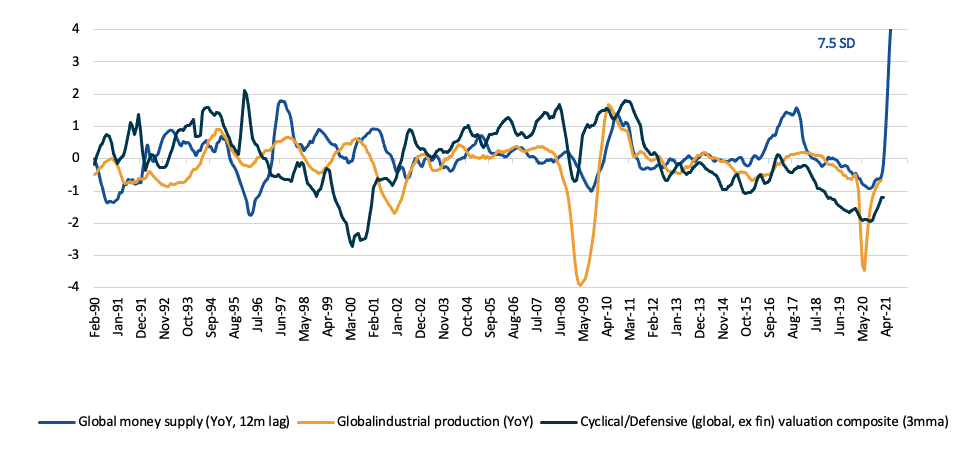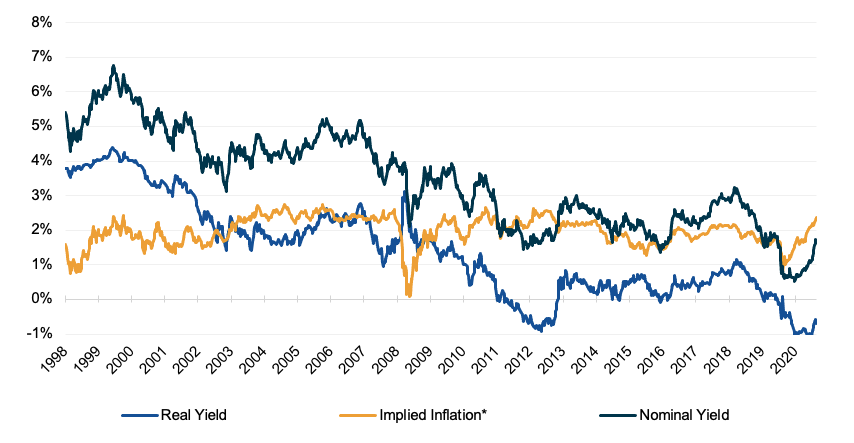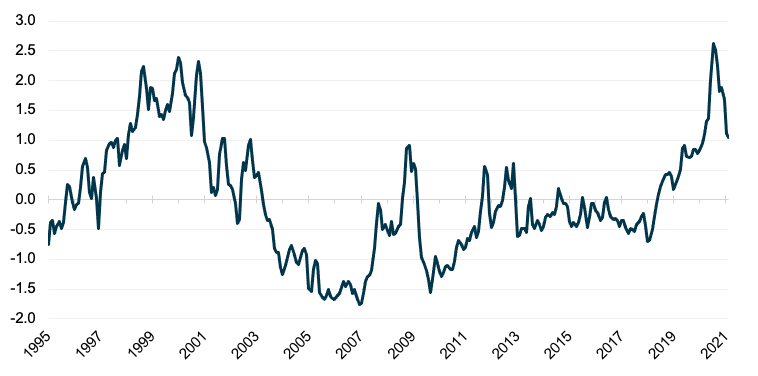Slowly, but surely: The emergence of new market leaders
The rotation into low multiple - or value - stocks has gathered pace in recent months following an acceleration in the vaccine rollout, combined with additional stimulus. US Treasury yields, which have lagged other expressions of the reopening trade, have started to catch up prompting the value rally to broaden out beyond growth cyclicals.
However, while we have seen some steepening of the yield curve, real yields remain firmly negative, which is extraordinary given developments in the global economy.
One year on from “coronavirus” entering household vocabulary, the global economic cycle has rebounded but remains below trend (yellow line in figure 1). Emerging economies are leading the developed world despite the slower vaccine rollout and little stimulus. A diligent handling of the virus in the early stages supported domestic activity, and stimulus in the US has buoyed exports. To that point, China’s industrial production and exports now exceed 2019 levels.
The US economy is motoring along thanks to a fiscal-driven consumption boom, while lingering restrictions in Europe, from a slower than expected vaccine rollout, and less stimulus sees the Eurozone limp along. Europe’s manufacturing activity has been supported by China’s robust recovery, but the services economy remains stubbornly below trend.
Arguably Europe has the most cyclical economic upside as the rollout in vaccines accelerates.
The printing press has been cranked - what does this mean for global equities?
The amount of stimulus undertaken by policy makers globally has reached astonishing levels (blue line figure 1), 40% of all money ever created occurred last year (money supply is defined as currency and demand deposits at commercial banks) and as previously mentioned it’s been led by the US.
This is not just in response to COVID-19 but also the rise in populism that’s been brewing. Quantitative easing is now being used to fund aggressive fiscal stimulus, which suggests the rebound in the economic cycle is still in its early stages.
Figure 1: Global money supply, industrial production & cyclical v defensive (z-score)

The Democrats wasted little time approving the $1.9 trillion Rescue Plan Act in March 2021. This package will deliver a 10% - 30% jump in disposable income for the bottom 60th percentile of US households over the next 12 months, predominantly via a one-off $1,400 payment per individual. This follows $160 billion of stimulus ($600 per individual) distributed by former President Trump in his last days of office in January 2021.
Consequently, US household balance sheets have never looked stronger.
Personal savings rates have reached abnormally high levels - around 20% of disposable income versus 7% pre-COVID. By the middle of this year we estimate US households will have above-trend excess savings of $3 trillion when a full reopening of the economy is scheduled. This $3 trillion is broken down by $1 trillion courtesy of underspending in 2020 and $2t from income stimulus.
Even if just one-third of this is spent it equates to 5% of GDP, which gives a sense of the firepower that could be deployed. Biden’s rumoured c. $1.5 – 2 trillion American Families Plan package, targeting social infrastructure and extending stimulus for lower income households, could bolster consumption even further.
The question for investors is, how will this excess savings be spent?
The $1 trillion in underspending in 2020 was concentrated in the services sector, but there is a natural limit to, for example travel consumption and dining out. Households could direct excess savings to big ticket items, ‘trading-up’, real or financial assets. Consequently, we have rotated our ‘Reopening’ cluster to position for consumption trends which we believe will emerge, such as autos, while reducing exposure to reopening candidates which have already seen strong performance such as financials, retail, and international-dependent travel.
Undoubtedly some of this excess savings is finding its way into the stock market. The events in January from the ‘Gamestop crowd’ show just how powerful the online retail community has become. The introduction of zero commission retail trading is a significant shift in market structure, and it will be prudent to continue to closely monitor crowded longs and shorts.
Investment stimulus can extend the cycle
As we previously suggested vaccines are providing policy makers the scope to pivot stimulus away from income support to investment programmes.
This is a critical point for long term investors.
On the heels of the Rescue Plan Act the Democrats proposed a $2.25 trillion Investment and Infrastructure Bill.
We expect other economic blocs to follow suit, and indeed decarbonisation is already a central pillar of policy across the US, Eurozone and China. Renewables only account for 7% of total energy output across the globe and needs to increase to substantially above 50% to meet emission targets under the Paris Agreement. We see a multi-decade investment cycle for green electricity.
Whilst the market has begun to view economically sensitive stocks through a different lens, cyclicals are still broadly cheap relative to defensives (dark blue line in figure 1).
This move from income stimulus to investment led stimulus/growth can lead to a more permanent shift in investment preferences, and a more durable outperformance of low multiple stocks, much like what was seen after the 2000 tech wreck.
There will be new candidates that can transition to secular growth winners and some of today’s perceived stock market winners will be revealed as growth traps.
Stimulus with a side of inflation?
Whether excess savings and pent-up demand proves inflationary depends on the marginal propensity to consume real goods or services, and the velocity at which savings are deployed. However, combined with re-shoring of supply chains, and broad pressure in supply chains from a shortage of semiconductors, we are likely to see higher volatility in inflation.
The move in 10Y US Treasury yields over the quarter was significant - from 0.9% to around 1.7% - but largely tracks rising inflationary expectations. Real yields remain negative at c. -0.6%; a disconnect between the bond market and the outlook for the global economy (figure 2).
Figure 2: Nominal yields, real yields & implied inflation (10-year rates)

* 10Y average inflation rate expected by the bond market. Source: FactSet
A normalisation in real yields can act as a further tailwind for cyclical stocks and a material headwind for the overvalued and weaker parts of the growth complex.
Some companies have received a ‘free pass’ from COVID-19 and negative real rates; not all are genuine disruptors, and many will see growth rates slow in a re-opened environment. That is, a move in real rates can act as an additional catalyst to tighten multiple dispersion (figure 3).
Figure 3: Global sector-neutral composite valuation of expensive relative to cheap (z-score)

Source: FactSet, Antipodes
Assessing risks
Whilst most central banks seem unwavering in their current policy positions, we are watching the People’s Bank of China (PBOC) closely as it appears credit creation in China has peaked as the recovery gathers steam.
The question is whether the recovery in the US and Europe can offset tightening in China. We believe China will remain selective in both tightening and stimulus, focusing on the ongoing rebalancing of the economy towards consumption and decarbonisation.
Money creation in the US is about 30% higher than the rest of the world, and we believe there will be a hangover from this extraordinary stimulus. The US fiscal deficit is 15% of GDP coupled with a large current account deficit. There is no free lunch. These twin deficits ultimately need to be funded, which can happen via higher rates to attract capital or a weaker currency. We believe it will be the latter.
Recent strength in the USD, due to a lead in vaccine rollout and stimulus-led growth, is unlikely to last as the rest of the world catches up. We maintain our underweight to the USD and favour current account surplus country currencies with key overweights in the Yen and Euro.
On the COVID-19 front, we are watching developments in India and Brazil closely along with evidence of a broader spread of the South African variant (e.g. in New York and other US cities), and the emergence of any new variants. Whilst existing vaccines have lower efficacy in preventing symptoms of today’s known variants, they remain strikingly effective preventing hospitalisations and fatalities. Pfizer and Moderna are well progressed developing booster vaccines targeting known mutations, which may see emergency use authorisation around the fourth quarter. Having said that, a dependence on the ongoing development of booster vaccines has the potential to complicate reopening.
We are also watching the vaccine rollout in emerging markets, as cross border reopening is dependent on a global pathway to herd immunity.
You can listen to our market update and review of Q1 2020 in the latest episode on the Good Value podcast - The emergence of new market leaders.
Pragmatic positioning for the evolution of market leadership
A natural healing in the global economy from an acceleration in vaccines can be supported by stimulus, but reopening remains fluid.
Globally, investors can expect monetary and fiscal policy to remain loose, with a focus on government sponsored investment programmes. This can lead to a more permanent shift in investment preferences where extreme multiple dispersion starts to contract and new market leaders start to emerge.
Any normalisation in real rates will accelerate this contraction.
To give readers an idea of how we think long term investment portfolios can be best positioned, here’s a brief overview of four of our largest holdings as at the end of the first quarter.
Siemens (ETR: SIE) and Volkswagen (FRA: VOW) are two companies traditionally labelled as “cyclicals” that we think can transition to secular growth market leaders. VW’s all-in approach to electrification can see the company take market share as EVs take an increasingly larger slice of the auto pie.
Siemens, a global leader in factory automation, will be a winner in a low carbon world as manufacturing lines are re-designed and re-tooled. Additionally, Siemens’ subsidiaries manufacture wind turbines and equipment required to fortify the grid.
At the other end of the barbell sit Facebook (NASDAQ: FB) and Microsoft (NASDAQ: MSFT), two companies that are the definition of pragmatic value; resilient businesses exposed to long-term structural trends valued at attractive multiples relative to their growth profiles.
Workloads will continue to move to the cloud, now led by the enterprise, and it’s Microsoft that has the enviable lock over this customer. And Facebook, a winner in a world where ecommerce is increasingly influenced by social media. Monetisation can inflect as users consume within the Facebook ecosystem and as the platform continues to take share in online advertising due to user engagement.
An unconstrained, pragmatic approach to global equities. Discover more about Antipodes.
Visit the Antipodes website, follow Antipodes on Linkedin or click the contact button below to make a direct enquiry.
2 topics
1 stock mentioned

